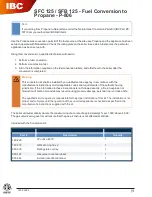
Installation 5
0020186710_06 ecoTEC exclusive Installation and maintenance instructions
11
5.1.3
Using the correct gas type
Using the incorrect gas type may cause fault shutdowns in
the product. Ignition and combustion noise may occur in the
product.
▶
Only use a gas type from the gas group that is defined on
the data plate.
5.1.4
B23 installation
A flue system for permitted unit type B23 (atmospheric gas-
fired wall-hung boilers) requires careful planning and imple-
mentation.
▶
Observe the product's technical data when planning.
▶
Use the recognised rules of technology.
5.1.5
Information and specifications for installing
the B23P
Pipe lengths in the B23P installation (
→
Page 32)
The flue gas system must at least correspond to the classi-
fication T 120 P1 W 1 in accordance with EN 1443.
The maximum pipe length (straight pipe only) corresponds to
the maximum permitted flue gas pipe length without any el-
bows. If elbows are used, the maximum pipe length must be
reduced in accordance with the dynamic flow characteristics
of the elbows. Elbows must not be connected directly after
one another as this method dramatically increases pressure
losses.
In particular, if the flue pipe is installed in cold rooms or out-
side of the building, the freezing point on the surface of the
inside of the pipe may be reached. A proven design in ac-
cordance with EN 13384-1 for a maximum boiler load at a
flue gas temperature of 40 °C must be used to prevent this
problem. The product must not be connected to a cascade
flue gas system that is being used by other units.
▶
Observe the applicable international, national and local
regulations for flue gas systems, in particular for installa-
tions in living rooms. Inform the operator how to correctly
operate the product.
5.1.6
Required preliminary work
1.
Install a stop cock in the gas line.
2.
Make sure that the existing gas meter is capable of
passing the rate of gas supply required.
3.
Check that the volumetric capacity of the expansion
vessel is sufficient for the system volume.
Conditions
: The volume of the installed expansion vessel is insufficient
▶
Install an additional expansion vessel, connected as
close to the product as possible, in the heating return.
4.
Install a tundish with siphon for the condensate dis-
charge and the exhaust pipe on the expansion relief
valve. Lay as short a drain line as possible, at a down-
ward gradient away from the tundish.
5.
Insulate bare pipes exposed to environmental influ-
ences to protect them from frost using suitable insu-
lating material.
5.2
Installing the gas connection
1
1.
Install the gas line in accordance with the recognised
rules of technology.
2.
Connect the product's gas connection
(1)
to the gas line
in accordance with the recognised rules of technology.
3.
Remove the residues from the gas line by blowing
through the gas line beforehand.
4.
Purge the gas line before start-up.
5.3
Checking the gas line for leak-tightness
▶
Check the entire gas line properly for leak-tightness.
5.4
Installing the cylinder connections
C
B
A
3
2
1
1.
Remove the circulation section
(3)
by undoing the
screws in the clamps
(2)
and removing the clamps.
Note
If you are not connecting any cylinder, you
must leave the circulation section installed.
2.
Connect the cylinder connections
(1)
to the domestic
hot water cylinder.












































